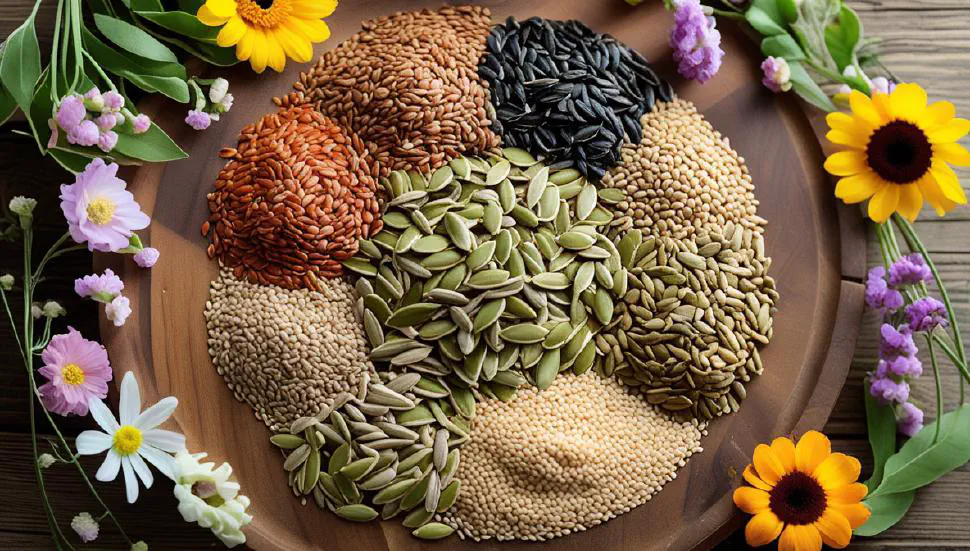Balancing hormones can feel like a daunting task in today’s fast-paced world, leaving many women searching for natural remedies. Seed cycling, a practice involving the strategic consumption of specific seeds during different phases of the menstrual cycle, has gained attention as a simple yet effective approach to achieving hormonal harmony. Rooted in nutritional science, this method is believed to offer various health benefits, from improved menstrual health to enhanced fertility and glowing skin.
The foundational concept of seed cycling revolves around the menstrual cycle’s natural phases, with flax and pumpkin seeds recommended during the follicular phase and sesame and sunflower seeds during the luteal phase. These seeds are rich in essential nutrients like omega-3 and omega-6 fatty acids, zinc, and vitamins that support hormone balance, offering a natural solution for those seeking alternatives to traditional treatments. Advocates of seed cycling suggest that integrating this practice into daily routines can lead to noticeable improvements in overall well-being.
This guide delves into the intricacies of seed cycling, providing a comprehensive chart and detailed instructions to help you incorporate it into your lifestyle effectively. From understanding the roles of different seeds to overcoming common challenges, this article aims to equip you with the knowledge you need to embark on your journey toward hormonal harmony and improved health.
What is Seed Cycling?
Seed cycling is a holistic nutrition practice aimed at supporting hormone balance throughout a woman’s menstrual cycle. The practice involves consuming specific seeds during different phases of the cycle: the Follicular and Luteal phases.
Here’s a breakdown of seed cycling:
- Follicular Phase (Day 1-14): Consume 1 tablespoon each of flax seeds and pumpkin seeds daily. These seeds are believed to support estrogen production and provide omega-3 fatty acids.
- Luteal Phase (Day 15-28): Switch to 1 tablespoon each of sesame seeds and sunflower seeds daily. These are thought to boost progesterone levels and offer a source of zinc.
Benefits of seed cycling are largely anecdotal, with supporters claiming it can help regulate menstrual cycles, reduce symptoms of PMS, and alleviate hormonal imbalances. It may also assist with irregular periods, mood swings, and acne.
While scientific evidence is limited, many people have reported positive changes. Postmenopausal women also use seed cycling to manage menopause symptoms like hot flashes and weight gain. If you’re curious, try integrating flax, pumpkin, sesame, and sunflower seeds into your routine to see if it benefits you.
Benefits of Seed Cycling
Seed cycling has gained popularity for its potential to support hormone balance throughout different phases of a woman’s life. The practice involves consuming specific seeds that are believed to promote a healthy balance of estrogen and progesterone, which are crucial for managing menstrual cycles, fertility, and skin health. While scientific backing is still needed, many individuals have claimed improvements in their symptoms, making it a worthwhile consideration for those facing hormonal imbalances or related health issues.
Hormone Balancing
Seed cycling is a natural method tied to the menstrual cycle phases. It involves eating specific seeds that provide nutrients like lignans, omega-3 fatty acids, and vitamin E, which are considered helpful for hormone balance. These nutrients can aid in regulating estrogen and progesterone, key hormones that influence various aspects of health. Many have found relief from PMS symptoms and menstrual irregularities through seed cycling. The practice is versatile and can also support hormone balance during different life stages, including menopause and postpartum periods. Despite the lack of extensive scientific studies, anecdotal evidence points to its potential benefits.
Enhanced Fertility
For those trying to enhance fertility, seed cycling is often recommended as a complementary approach. By potentially balancing hormones, seed cycling may increase fertility. Antioxidants in seeds can reduce inflammation, which might improve chances of implantation. Many supporters of seed cycling report overcoming infertility using this practice, though these experiences are largely anecdotal. The hormone-regulating effects attributed to seed cycling might also stimulate ovulation, further supporting fertility. While personal experiences suggest positive outcomes, more research is needed to confirm these effects.
Menstrual Health Improvement
Managing menstrual health is a primary reason why many women turn to seed cycling. The practice involves consuming flax and pumpkin seeds during the follicular phase and switching to sesame and sunflower seeds during the luteal phase. These seeds are thought to maintain a healthy balance of estrogen and progesterone, which is essential for a smoother menstrual cycle. The nutrients found in these seeds, such as lignans and phytoestrogens, are particularly noted for their potential in regulating estrogen levels. Regularly practicing seed cycling can reduce PMS symptoms and could even help stimulate menstruation in cases of amenorrhea. Some studies suggest that flax seeds improve estrogen levels in postmenopausal women, indicating benefits for menstrual health.
Skin and Hair Benefits
Beyond hormonal balance and fertility, seed cycling is believed to positively impact skin and hair health. By potentially stabilizing hormone levels, it may address issues like acne caused by hormonal imbalances. Omega-3 fatty acids and vitamins found in seeds are thought to promote healthier skin and may also contribute to shinier, stronger hair. Proponents suggest that these benefits stem from the body’s improved ability to regulate hormones through seed cycling, leading to clearer skin and healthier hair. Although these effects are largely anecdotal, many individuals have shared personal success stories, highlighting the role of seed cycling in achieving better skin and hair health.
How Seed Cycling Works
Seed cycling is a holistic method designed to foster hormone balance throughout the menstrual cycle. By consuming certain seeds during specific phases, individuals aim to regulate estrogen and progesterone levels. This practice may help alleviate symptoms like irregular periods, mood swings, and PMS. During the follicular phase of the menstrual cycle, the focus is on consuming flax and pumpkin seeds. These seeds support healthy estrogen levels due to their richness in lignans and omega-3 fatty acids. In contrast, the luteal phase emphasizes consuming sunflower and sesame seeds. Known for containing zinc, vitamin E, and omega-6 fatty acids, these seeds aid in boosting progesterone production. While many people swear by its benefits, scientific research on seed cycling’s efficacy remains limited. Nonetheless, seed cycling presents a gentle, natural approach to maintaining hormone health.
Phases of the Menstrual Cycle
The menstrual cycle comprises two main phases: the follicular phase and the luteal phase. The follicular phase starts on the first day of menstruation and extends to ovulation. During this phase, estrogen gradually rises, preparing the body for potential pregnancy. Ovulation occurs at the mid-point of the follicular phase, marking the release of an egg and highlighting the fertile window of the cycle. Following ovulation, the luteal phase takes place, continuing until the next menstruation begins. Progesterone becomes the dominant hormone during this phase. Various factors, including lifestyle habits like stress and diet, can influence these hormonal shifts. This means hormone balance can be affected by daily choices, potentially impacting menstrual health and symptoms.
Role of Different Seeds
Each seed plays a unique role in seed cycling, contributing to potential hormone balance throughout the menstrual cycle. Flax seeds are bursting with lignans. These plant compounds mimic estrogen and help in removing excess estrogen from the body, making them perfect for the follicular phase. Pumpkin seeds, loaded with zinc, support progesterone production crucial for the luteal phase. Sesame seeds, introduced later in the cycle, are rich in both zinc and lignans. They aid in regulating estrogen levels, complementing the effects of flax seeds. Lastly, sunflower seeds bring vitamin E to the table, which helps boost progesterone levels and can ease PMS symptoms. Together, these seeds form a natural and nutrient-rich approach to balancing hormones. By aligning seed intake with the menstrual cycle phases, seed cycling leverages the distinct nutrient profiles of each seed.
Seeds Used in Seed Cycling
Seed cycling is a natural method used to support hormone balance across the menstrual cycle. This practice involves incorporating specific seeds during the two main phases of the cycle: the follicular and luteal phases. The seeds used are flax seeds, pumpkin seeds, sesame seeds, and sunflower seeds. During the follicular phase, consuming flax and pumpkin seeds can help boost estrogen levels. In the luteal phase, sesame and sunflower seeds aid with progesterone production. Each seed type offers unique nutrients contributing to hormone regulation. Understanding how and when to integrate these seeds can be beneficial for women experiencing irregular periods or hormonal imbalances.
Flax and Pumpkin Seeds (Follicular Phase)
During the follicular phase of the menstrual cycle, the focus is on supporting estrogen production. This phase spans from days 1 to 14. Both flax and pumpkin seeds are key players here. Consuming one tablespoon of each daily can promote estrogen levels needed to build the endometrium. Flax seeds are packed with omega-3 fatty acids and lignans, which may help balance hormones. Grinding these seeds is recommended to enhance their absorption in the body. Pumpkin seeds, rich in zinc, also contribute to balanced hormone levels. Incorporating these seeds consistently can help regulate the menstrual cycle and ease symptoms of hormonal imbalances.
Sesame and Sunflower Seeds (Luteal Phase)
The luteal phase occurs from days 15 to 28 of the menstrual cycle. It is crucial for supporting progesterone production, and the seeds used during this phase are sesame and sunflower seeds. Sesame seeds contain lignans that help regulate estrogen and testosterone levels. They can be sprinkled over dishes to support hormone metabolism. Sunflower seeds are rich in vitamin E and selenium, nutrients essential for progesterone production and liver detoxification. These seeds aid in reducing menstrual-related symptoms and help create a balance in sex hormones. Ground sesame and sunflower seeds can be added to smoothies, oatmeal, or salads to enhance nutrient absorption. This practice aligns with the natural hormonal changes occurring during the luteal phase, promoting overall hormone harmony.
Nutritional Components of Seeds
Seed cycling is a natural method that involves consuming specific seeds during different phases of the menstrual cycle to support hormonal balance. Each type of seed offers unique nutritional benefits. For instance, flax seeds are high in lignans, which help regulate excess estrogen. Pumpkin seeds provide zinc, essential for progesterone production and ovulation support. Sunflower seeds offer vitamin E and selenium, which are crucial for hormone detoxification and progesterone synthesis. Sesame seeds are also rich in lignans, aiding in estrogen and testosterone regulation. When consumed in seed cycling, these seeds provide a blend of vitamins, minerals, and essential fatty acids, promoting overall well-being and hormonal health.
Omega-3 and Omega-6 Fatty Acids
Omega-3 and omega-6 fatty acids are vital for maintaining hormonal balance. Flax and sesame seeds are excellent sources of omega-3s, which help balance sex hormones such as estrogen and progesterone. These fatty acids also support healthy ovulation and longer luteal phases. In particular, omega-3 plant-based sources like those in sesame seeds can benefit menopausal women, enhancing hormone status and reducing inflammation. Consuming a diet rich in omega-3 fatty acids from nuts and seeds like flax has been linked to improved hormone health in postmenopausal women.
Zinc and Vitamin E
Zinc and vitamin E are crucial components in seed cycling, supporting hormone balance. Zinc, found in pumpkin and sesame seeds, plays a key role in progesterone production during the luteal phase. It helps balance progesterone and estrogen levels by lowering androgens. During the luteal phase, the combination of zinc from sesame seeds and vitamin E from sunflower seeds assists the body in producing more progesterone. Furthermore, vitamin E promotes the corpus luteum’s function, increasing progesterone levels during the menstrual cycle. These nutrients contribute significantly to overall hormone health.
Selenium and Other Minerals
Selenium is an essential nutrient present in sunflower seeds that aids in thyroid function and hormonal health. Pumpkin seeds are also rich in zinc, a mineral important for hormone production. Sunflower seeds provide vitamin E, further supporting hormonal balance. Additionally, flax and sesame seeds contain phytoestrogens, plant compounds influencing estrogen levels in the body. When combined with beta carotene, selenium acts as an antioxidant, bolstering the immune system. This combination, found in seeds used for seed cycling, underscores the vital role of selenium and other minerals in maintaining hormonal equilibrium.
Implementing Seed Cycling
Seed cycling is a holistic approach aimed at balancing hormones throughout the menstrual cycle. This practice involves consuming specific seeds during different phases of the menstrual cycle to help regulate estrogen and progesterone levels. By eating flax and pumpkin seeds in the follicular phase (days 1–14) and switching to sesame and sunflower seeds in the luteal phase (days 15–28), people seek to alleviate symptoms of hormonal imbalances. Nutrients in these seeds may aid in modulating estrogen levels and support hormone production. Although anecdotal evidence suggests positive outcomes, scientific backing is limited. It is important to pair seed cycling with other healthful lifestyle changes for the best results.
Daily Routine Integration
Incorporating seed cycling into your daily routine is simple but requires consistency. During the follicular phase (days 1–14), you should consume one tablespoon each of flaxseeds and pumpkin seeds daily. This practice shifts to sesame and sunflower seeds in the luteal phase (days 15–28). Regular intake of these seeds is crucial, as changes in hormone balance may take three to six months to appear. To make this part of your routine, try adding seeds to meals like smoothies or salads. Grounding seeds ensures better absorption of nutrients, so using a grinder and storing seeds in airtight containers is recommended. With patience and regularity, seed cycling aims to support hormone balance and menstrual health.
Grinding and Storing Tips
Grinding seeds is a vital step in seed cycling, as whole flax seeds are not effectively absorbed by the body. Using raw seeds, which are neither roasted nor salted, helps keep all their nutrients intact. Once ground, seeds should be stored in an airtight container to maintain freshness and prevent nutrient loss. This approach ensures seeds remain potent and beneficial. For convenience, pre-ground seed cycling blends are available on the market. Although grinding daily provides the freshest supply, these blends offer a practical alternative. By maintaining consistency in grinding and storage, one can maximize the benefits of seed cycling.
Adapting for Amenorrhea or Menopause
Seed cycling isn’t just for those with regular cycles—it can be adapted for women experiencing amenorrhea, menopause, or post-menopause. For women without regular menstrual cycles, seed cycling can begin at any point, rotating through each seed combination in two-week intervals. In cases of irregular cycles or menopause, aligning the practice with the lunar cycle can be effective, using the full moon and new moon as guide points. For menopausal women, following seed cycling with these interval rotations may support hormone balance, aiding progesterone production through nutrients like zinc and omega-6 fatty acids. This approach provides a natural method for maintaining hormonal health even in the absence of a menstrual cycle.
How to Use the Seed Cycling Chart
A seed cycling chart is your guide to balancing hormones through natural food sources. It outlines which seeds to consume during each phase of your menstrual cycle to support hormonal balance. Here’s how to use it:
Follicular Phase (Days 1-14)
- Consume 1 tablespoon of ground flax seeds daily.
- Add 1 tablespoon of ground pumpkin seeds each day.
These seeds help balance estrogen levels and are a great source of omega-3 fatty acids.
Luteal Phase (Days 15-30)
- Eat 1 tablespoon of ground sesame seeds daily.
- Include 1 tablespoon of ground sunflower seeds each day.
These seeds support progesterone production and help with hormonal balance during this phase.
For those with irregular periods, menopause symptoms, or who are postmenopausal, the chart suggests starting seed cycling on a specific day and keeping each seed rotation for two weeks.
Benefits of Seed Cycling:
- Improves hormonal imbalances
- Eases painful periods
- Helps with hot flashes and weight gain
- Supports a healthy balance of estrogen and progesterone
Using the chart simplifies the process and ensures a consistent rotation of seeds. Adjusting your diet with this method could be key to easing menstrual and menopause symptoms.
Common Challenges and Solutions
Seed cycling, though beneficial, comes with its own set of challenges. Many individuals experience digestive issues like bloating and gas due to the high fiber content in seeds. Additionally, eating seeds in large amounts may lead to hormonal imbalances, such as estrogen dominance. Allergic reactions, like itching or swelling, are also possible when new seeds are introduced. Furthermore, seed cycling could interfere with the effectiveness of some medications, including blood sugar and blood-thinning drugs. Moreover, seeds are calorie-dense, which can lead to weight gain if not balanced with the rest of your diet. Being aware of these common issues helps in finding solutions that make seed cycling more effective and comfortable.
Consistency and Patience
Consistency is key when embracing seed cycling as a natural method for hormone regulation. It’s vital to stick with the routine over several months to see real benefits. The process takes time, often requiring three to four months before noticeable changes occur. It’s also important to combine seed cycling with other lifestyle changes, like a balanced diet and regular exercise, for better hormone support. Those managing conditions such as PCOS might find improvements in symptoms over time. Patience and perseverance are essential, as seed cycling is a gradual yet natural way to influence hormone balance.
Adjusting for Dietary Restrictions
For those with dietary restrictions, seed cycling remains accessible with some adjustments. Seeds, rich in lignans and omega fatty acids, can fit various dietary needs through substitution or creative cooking methods. Incorporating seeds into smoothies, granola, or salads allows flexibility while maintaining nutrient intake. People with seed allergies should consider alternate hormone-balancing approaches or consult healthcare professionals. The technique can adapt to plant-based or gluten-free diets using adaptable seeds preparations like seed milks or hummus. Despite its adaptability, attention to allergens and dietary needs is crucial, ensuring a personalized approach to hormone management.
Scientific Perspective on Seed Cycling
Seed cycling is a dietary practice that aims to balance hormones by using specific seeds during different parts of the menstrual cycle. It targets estrogen and progesterone levels. Though scientific evidence is limited, some people find it helpful.
Seed Cycling Overview
- Follicular Phase (Day 1-14): Consume flaxseeds and pumpkin seeds.
- Luteal Phase (Day 15-28): Incorporate sesame seeds and sunflower seeds.
Nutrients and Potential Benefits
- Flaxseeds: Rich in lignans, which are phytoestrogens, potentially helping to balance estrogen levels.
- Pumpkin Seeds: High in zinc, beneficial for hormonal health.
- Sesame Seeds: Also contain lignans, aiding in estrogen modulation.
- Sunflower Seeds: Good source of omega-3 fatty acids, supporting overall health.
While the scientific community has yet to confirm the effectiveness of seed cycling, the practice uses the “food as medicine” approach. It might offer some relief from symptoms like irregular periods and excess estrogen. Many also believe it can aid in managing menopause symptoms such as hot flashes and weight gain.
Practical Tips for Success
Practical Tips for Success in Seed Cycling
Seed cycling can help achieve hormonal balance by supporting the menstrual cycle. Here’s how to do it effectively:
- Daily Routine:
- During the Follicular Phase (Day 1-14), consume:
- 1 tablespoon of flax seeds
- 1 tablespoon of pumpkin seeds
- Switch to the Luteal Phase (Day 15-28):
- 1 tablespoon of sesame seeds
- 1 tablespoon of sunflower seeds
- During the Follicular Phase (Day 1-14), consume:
- Consistency is Key:
- Stick with this routine for 3-6 months to notice benefits such as improved hormone balance and reduced menopause symptoms.
- Optimal Preparation:
- Use fresh seeds and grind them for better absorption.
- Store leftover seeds in an airtight container to maintain their efficacy.
- Nutritional Benefits:
- Seeds provide lignans, omega fatty acids, zinc, and vitamin E.
- These nutrients help balance estrogen levels and support progesterone production.
By following these steps, you can make the most of seed cycling to possibly alleviate symptoms like painful periods and menopausal hot flashes.
Testimonials and Anecdotal Evidence
Seed cycling has garnered positive testimonials from many users who report various benefits. One user noticed improvements in energy levels and a reduction in hormonal migraines within six months. Another found that seed cycling made regulating their menstrual cycle easy over time. Incorporating seeds into morning meals made the routine effortless to maintain.
For postmenopausal women, some testimonials express a wish they knew about seed cycling earlier in their menopause journey. They experienced noticeable improvements in symptoms like hot flashes and weight gain. Users also report enhanced sleep and a general sense of hormonal change, suggesting a balance of estrogen and progesterone levels.
To summarize the testimonials:
- Improved energy levels
- Reduced hormonal migraines
- Easier menstrual cycle regulation
- Boosted sleep quality
- Balanced hormone levels
Seed cycling may be a simple yet effective way for those with hormonal imbalances or irregular periods to achieve hormonal balance. By using seeds such as flax seeds, pumpkin seeds, sunflower seeds, and sesame seeds, individuals can potentially address symptoms related to excess estrogen and hormonal fluctuations.
FAQs
Seed cycling is a naturopathic approach that many people use to balance their hormones naturally. This method involves eating specific seeds at different phases of the menstrual cycle. While users have shared positive experiences, scientific research is still limited on its effectiveness. During the follicular phase, you consume flax seeds and pumpkin seeds, while in the luteal phase, you switch to sesame and sunflower seeds. Consistency is key to noticing changes related to hormone balance, and it may take several months to observe any improvements. Though many find success, potential side effects could include digestive issues, hormonal imbalances, or allergic reactions. Some people also report weight gain or kidney-related concerns.
Can seed cycling help with PCOS?
Seed cycling can assist women with PCOS by helping to regulate estrogen and progesterone. This balance of sex hormones is crucial, as PCOS often results in hormonal imbalances. Through seed cycling, the right hormones are supported at each point in the menstrual cycle. It may lead to regular ovulation and periods for women dealing with PCOS.
By including seed cycling in their routine, women with PCOS can naturally manage symptoms like PMS bloating, fatigue, and mood swings. These are common in those with this condition. Many see seed cycling as a natural alternative to medication, providing a gentler way to balance hormones through diet.
For those committed to alleviating PCOS symptoms, staying consistent with seed cycling is essential. Over several months, they might experience improvements, reinforcing the benefits of this natural practice. While it requires patience, it offers hope for a more balanced hormonal state.




